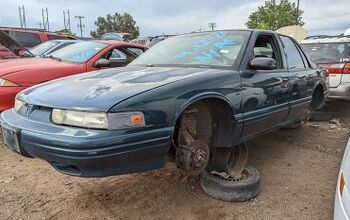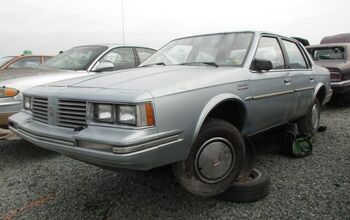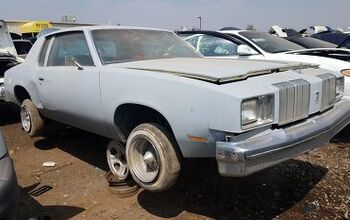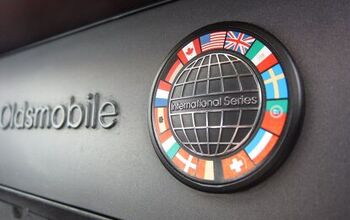Junkyard Find: 1978 Oldsmobile Cutlass 442

Yes, GM kept making Cutlasses with 442 badging long after the end of the muscle car era. Between 1970 and 1978, the 442 lost about 400 pounds of curb weight and (at least) 205 horsepower; the top 442 engine in ’78 was a 160-horse Chevy 305 V8.
This junked example has been wrecked horribly and then picked over pretty thoroughly, so it’s unlikely that anyone will be shedding any tears over its demise.
Still, the paint and graphics are pretty wild-looking for the era. A nicely restored 442 in this color scheme would be fun to have.
The Cutlass was quite a hot seller during the late 1970s, more or less the high-water mark for Oldsmobile sales in the United States, and the car was a pleasant enough, if thirsty, driver. I’ve had a couple of Cutlasses from this era, and (aside from the nightmarishly leaky T-tops on one) my memories of them are mostly positive.

Murilee Martin is the pen name of Phil Greden, a writer who has lived in Minnesota, California, Georgia and (now) Colorado. He has toiled at copywriting, technical writing, junkmail writing, fiction writing and now automotive writing. He has owned many terrible vehicles and some good ones. He spends a great deal of time in self-service junkyards. These days, he writes for publications including Autoweek, Autoblog, Hagerty, The Truth About Cars and Capital One.
More by Murilee Martin
Latest Car Reviews
Read moreLatest Product Reviews
Read moreRecent Comments
- Oberkanone Nope. No interest.
- SilverCoupe Tim, you don't always watch F1 as you don't want to lose sleep? But these races are great for putting one to sleep!I kid (sort of). I DVR them, I watch them, I fast forward a lot. It was great to see Lando win one, I've been a fan of McLaren since their heyday in CanAm in the late '60's.
- Cprescott The problem with this fable by the FTC is:(1) shipping of all kinds was hindered at ports because of COVID related issues;(2) The President shafted the Saudis by insulting them with a fist bump that torqued them off to no end;(3) Saudis announced unilateral production cuts repeatedly during this President's tenure even as he begged to get them to produce more;(4) We were told that we had record domestic production so that would have lowered prices due to increased supply(5) The President emptied the strategic petroleum reserve to the lowest point since the 1980's due to number 3 and then sold much of that to China.We have repeatedly been told that documents and emails are Russian disinformation so why now are we to believe this?
- Ollicat Another Biden attempt to say, "Look over there!"
- Kjhkjlhkjhkljh kljhjkhjklhkjh Who cares. Price of gas is not the issue. spending an extra 100$ a month over 4 tanks of gas is not the issue.this a political scam to distract really dumb people from the real issue. if rent and house payments were not up by 50% to as high as 150% higher in a ton of locations, then paying an extra 100$ in gas would be annoying but not really an issue. But the real-estate market with hedge fund investors, power-relator groups bought a ton of houses and flipped them into rentals and jacked up the rates uplifting the costs on everything else. and ironically no-one seems to be in any hurry to build more houses to bring those costs down because supply and demand means keeping less houses available to charge as much as you want. It is also not the issue as a secondary issue is child care costs and medical... again 100$ extra per month in gas is *nothing* compared to 800$ a month in ''child care'' and 300$ per visit to the doctor office, 300$ for a procedure less dentist trip..











































Comments
Join the conversation
This car is an AEROBACK and if anybody else refuses to give the body style proper respect I will Murder. You. To. Death. I luuuuvvvvv aerobacks.
The GM downsize of the full-size cars that rolled out in '77 was a huge hit, and deservedly so. They had deliberately let the big cars go to hell with obese styling and horribly rust-prone sheetmetal because they knew the next generation would be so different, they'd never be held accountable by the time the old ones rotted. The '77 and newer ones drove worlds better, looked better, hardly rusted (many, many survive in nice shape today), and sold like hotcakes, especially for Chevrolet. The next year, the equally bread-and-butter midsizers came up for the same downsizing treatment. Aesthetically and commercially, it was not as successful. One reason was that GM seemed to self-consciously try to make the cars an obvious size class smaller than the new full-sizers. I remember C/D commented at the time that the dashboard was small, the speedo was small, as if to scream that the whole car was now smaller. As noted, they were also woefully underpowered, which generally wasn't the case with the full-sizers and their perfectly adequate Chevy small-block V8s (across nearly all divisions, which figuratively blew up in their faces later -- but that's another story).